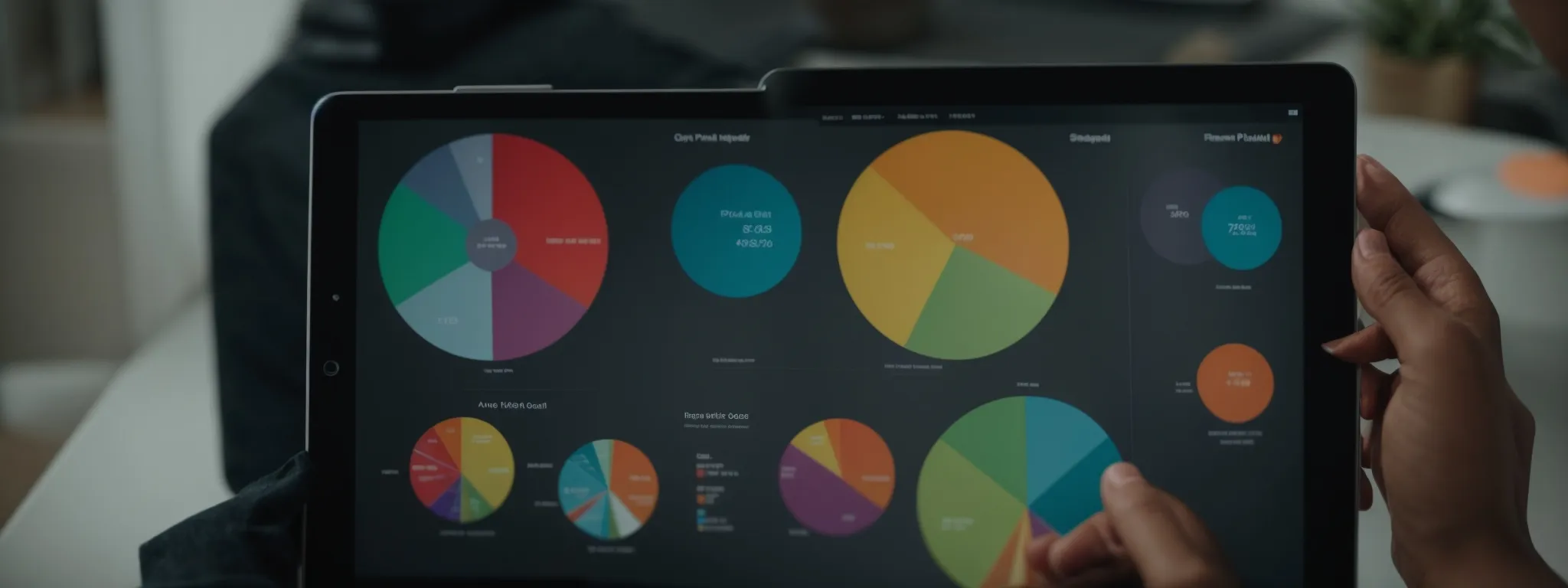Services for Small Business Online Marketing
Comprehensive Online Marketing Solutions for Small Businesses In the dynamic landscape of digital marketing, small businesses face a unique set of challenges and opportunities. Crafting a robust […]
Comprehensive Online Marketing Solutions for Small Businesses
In the dynamic landscape of digital marketing, small businesses face a unique set of challenges and opportunities.
Crafting a robust online marketing strategy is essential for small enterprises aiming to compete effectively and connect meaningfully with their target audience.
From the initial touchpoint of rendering a digital visit memorable to creating lasting engagements, the marketing toolbox is filled with tactics that can be customized for any small business’s objectives.
LinkGraph and SearchAtlas SEO software emerge as pivotal allies, equipping businesses with the resources to amplify their digital footprint.
Keep reading to unravel the transformative potential these tools offer in fortifying a small business’s online marketing efforts.
Key Takeaways
- Small Businesses Benefit From Tailored Digital Marketing Strategies to Resonate With Their Audiences and Achieve Growth Goals
- Tools Like SearchAtlas SEO Software Provide Valuable Insights and Optimizations for Small Business Marketing Efforts
- A Well-Designed Website With Optimized Content and User Experience Is Crucial for Converting Visitors Into Customers
- Engaging With Customer Feedback and Managing Online Reputation Is Key to Maintaining Brand Trust and Credibility
- Segmenting Email Lists and Crafting Personalized Campaigns Are Effective for Nurturing Leads and Driving Sales
Tailoring Marketing Strategies for Small Business Growth

In today’s bustling digital marketplace, small businesses must carve out a distinct space to not only survive but to thrive.
With a keen focus on growth, these enterprises require marketing strategies that resonate with their unique business goals and the audiences they cater to.
It is imperative to examine market trends and insights with a discerning eye, ensuring the alignment of marketing efforts with overarching business objectives.
Crafting a bespoke marketing plan is not a simple checklist but a multifaceted puzzle, bringing together varying channels and tactics into a cohesive, potent narrative.
A unified marketing approach can dramatically amplify a brand’s voice across the digital landscape, converting passive browsers into engaged customers and loyal advocates for the business.
Identifying Business Goals and Target Audience
For small businesses embarking on their digital marketing journey, the first essential step involves a clear articulation of their business goals and defining the ideal target audience. Goals can range from increasing brand awareness to boosting website traffic, whereas the target audience could vary from local patrons to a specific demographic interested in niche products.
Understanding these foundations allows for the development of tailored marketing solutions that speak directly to the consumers’ needs and desires. By aligning a marketing strategy with these core objectives, small businesses ensure that their marketing efforts are both efficient and effective, leading to a higher return on investment and a stronger market presence.
Analyzing Market Trends to Align With Objectives
Analyzing market trends is a critical component in crafting a marketing strategy that propels small businesses forward. By leveraging tools like SearchAtlas SEO software, companies gain insights into emerging patterns and consumer behaviors, allowing them to optimize marketing tactics and remain relevant and competitive in their industry.
With a specialized focus on understanding market dynamics, businesses can employ strategies such as SEO reputation management and PPC Google Ads strategies, effectively positioning their brand within the digital ecosystem. These endeavors lead to the creation of marketing initiatives that not only reach but resonate with the intended audience, ensuring marketing efforts are not just seen but are impactful.
Crafting a Personalized Marketing Plan
Developing a personalized marketing plan demands an intricate understanding of the company’s value proposition and the identification of the most effective channels to reach the intended audience. It involves selecting the right mix of digital marketing services, such as content marketing, social media campaigns, and PPC management, tailoring each component to echo the brand’s unique voice and objectives.
| Marketing Component | Objective | Tools and Strategies |
|---|---|---|
| Content Marketing | Engage and educate | SearchAtlas SEO software, SEO Content Assistant |
| Social Media Campaigns | Enhance brand presence | Digital PR services, targeted lead generation |
| PPC Management | Drive targeted traffic | PPC Google Ads strategies, Amazon PPC ads |
Before launching into the market, a rigorous analysis through a free SEO audit can illuminate opportunities for optimization. This step ensures the plan is not only customized to the business’s needs but is also prepared to adapt to the ever-evolving digital marketing environment, securing a competitive edge in a crowded marketplace.
Integrating Various Channels for a Unified Approach
Embarking on a marketing journey necessitates harmonizing various channels to ensure small businesses communicate a clear and consistent message. By Utilizing Platforms Like LinkGraph’s Content Planner, entrepreneurs can orchestrate content distribution that aligns with search trends and audience preferences, yielding a robust digital presence that engages across all fronts.
LinkGraph and SearchAtlas by LinkGraph are instrumental in bringing cohesion to the multifarious aspects of digital marketing. Their suite of tools allows businesses to seamlessly integrate tactics from SEO to PPC, fostering a synergistic environment where each marketing move is interconnected, enhancing the overall impact on the consumer’s journey.
Essential Digital Tools for Improving Online Presence

As the digital realm continues to evolve, small businesses require a suite of comprehensive online marketing solutions to ensure a robust online presence.
Central to this process is the construction and optimization of a dynamic website, recognized as the digital storefront for any modern enterprise.
This core component, coupled with the strategic leveraging of social media platforms, allows for a wide-reaching influence well beyond the limitations of traditional marketing practices.
Meanwhile, email marketing continues to serve as an indispensable tool for delivering personalized messages straight to the consumer’s inbox, fostering a direct connection with the audience.
To refine these strategies and ascertain their effectiveness, a meticulous incorporation of analytics is crucial, ensuring each marketing move is informed, focused, and strategically aligned with business growth objectives.
Website Development and Optimization Techniques
In the digital age, a small business’s success is often anchored to the strength of its online presence, making website development and optimization a critical junction in any digital marketing strategy. A seamlessly designed website acts as a virtual handshake with potential customers, offering a first impression that can either open doors to new business opportunities or close them indefinitely.
Optimization techniques such as on-page SEO, mobile responsiveness, and fast loading times are the unsung heroes that work tirelessly behind the scenes to ensure a website ranks favorably on search engines and delivers a user experience that converts visitors into customers. Implementing these practices secures a small business’s digital foundation, serving as a launchpad for all other marketing endeavors:
- Employing responsive design to accommodate a variety of devices and screen sizes ensures accessibility and user satisfaction.
- Optimizing site speed caters to the user’s need for quick information retrieval, affecting both engagement and rankings.
- Integrating on-page SEO by utilizing strategic keywords and meta data places the website in the limelight, increasing its visibility to the target audience.
Leveraging Social Media Platforms Effectively
For small businesses, the effective leverage of social media platforms is essential in cultivating relationships with customers and establishing brand awareness. By thoughtfully engaging with audiences through curated content and responsive interaction, businesses enhance their digital footprint and foster community.
Setting clear objectives, such as increasing customer engagement or driving sales, directs the implementation of targeted social media strategies. These goals become attainable through the meticulous planning and execution of activities on platforms best suited to reach the desired audience:
- Developing a content calendar to maintain a consistent posting schedule that keeps the audience engaged and informed.
- Designing campaigns that encourage interaction through contests, user-generated content, and direct messaging to deepen customer relationships.
- Analyzing social media metrics to provide insights into campaign performance and areas for strategic refinement.
Investing time in understanding the nuances of each social media channel enables small businesses to deliver impactful messages that resonate with their audience. This approach ensures that every move on these platforms contributes meaningfully to the overarching marketing strategy and business growth.
Utilizing Email Marketing for Personalized Outreach
Email marketing stands as a pivotal component of comprehensive online marketing solutions, particularly for small businesses seeking to foster enduring customer connections. This channel facilitates the delivery of customized messages that resonate with the consumer, leading not only to enhanced client engagement but also to the reinforcement of brand loyalty.
In an age where personalization can set a business apart, leveraging the power of email marketing allows for direct and intimate communication with the audience. Small businesses can harness this tool to announce new product offerings, share exclusive insights, or provide valuable content, all of which are tailored to the specific interests and behaviors of their subscriber base.
Incorporating Analytics for Performance Tracking
In the digital marketing ecosystem, incorporating analytics stands as a lynchpin for any small business intent on tracking the effectiveness and return on their marketing investments. Tools such as LinkGraph and SearchAtlas by LinkGraph furnish business owners with comprehensive data that illuminate key performance indicators, from website traffic patterns to conversion rates, guiding data-driven decision-making processes.
With a precise analytical approach, businesses can fine-tune their digital marketing strategies, identifying which tactics yield the highest engagement and customer acquisition. This constant vigilance and adjustment, powered by SearchAtlas SEO software’s advanced analytics, ensures that marketing budgets are allocated to initiatives that directly contribute to a small business’s growth and online presence optimization.
Leveraging Social Media to Connect With Customers

In the quest to elevate the online presence of small businesses, the strategic use of social media stands out as a cornerstone in contemporary digital marketing strategies.
Recognizing the profound impact of social media on customer relationships and brand visibility necessitates a meticulous approach to selecting apt platforms that align with a business’s brand values and audience demographics.
At the heart of an effective social media presence lies the curation of a content calendar, which ensures a regular cadence of posts to captivate and inform the audience.
Additionally, fostering a vibrant community hinges on authentic social interaction, where engagement is not an afterthought but a core marketing pillar.
Moreover, the power of targeted social media campaigns, when deployed with precision, can amplify reach and influence, transforming passive followers into active participants in a brand’s narrative.
Selecting the Right Platforms for Your Business
Selecting the right social media platforms is a pivotal decision for small businesses aiming to maximize their digital impact. The choice should be informed by a deep analysis of where a business’s target audience spends their time and engages with content: are they browsing Instagram, interacting on Twitter, or networking on LinkedIn?
A successful social media strategy hinges on identifying these behavioral patterns and matching the business’s communication style to the platform’s distinct environment. Crafting content uniquely suited to each platform will resonate with the intended consumer base and bolster a business’s brand narrative and reach.
| Social Media Platform | Audience Demographic | Content Style |
|---|---|---|
| Younger, visually-driven audience | Image-heavy, storytelling approach | |
| Broad, real-time information seekers | Concise updates with a conversational tone | |
| Professional, career-focused individuals | Educational and thought leadership content |
Creating a Content Calendar for Consistent Posting
In the digital marketing sphere, establishing a content calendar is a strategic move that anchors a small business’s social media efforts. This systematic approach ensures the release of content is timely and consistent, fostering sustained engagement with the target audience and bolstering the brand’s online visibility.
A well-structured content calendar serves as a roadmap for a business’s social media activity, outlining when and what content will be shared. This disciplined schedule is pivotal: it maintains a rhythm that keeps a business top-of-mind for consumers and helps in avoiding any last-minute scramble to post content:
- Defining key dates and campaign milestones to align content with relevant events or promotions.
- Allocating specific themes or topics to different days of the week to provide variety and maintain audience interest.
- Strategically timing posts to correspond with peak user activity on each social media platform for maximum engagement.
Engaging With the Community Through Social Interaction
Engagement with the community through social interaction is paramount for small businesses seeking to solidify their presence on social media platforms. This necessitates a proactive approach, where community management becomes a strategic pillar, ensuring that every comment, message, and review receives a personalized response, reflecting the brand’s commitment to customer service.
Such social interactions not only build customer loyalty but also encourage word-of-mouth advocacy, which is integral to expanding a small business’s reach. Proactive engagement, coupled with an understanding of consumer sentiments, allows a small business to refine its messaging and foster a sense of community, fueling both growth and brand vitality within digital arenas.
Running Targeted Social Media Campaigns
Targeted social media campaigns stand as a linchpin in the arsenal of online marketing solutions for small businesses. By deploying tailored content and advertising towards specific segments of their audience, these businesses can drive impactful engagements and heightened conversion rates, thus capitalizing on the myriad opportunities inherent in social media channels.
Through the use of Sophisticated Analytics and Demographic Targeting Techniques, small businesses are enabled to deliver their messages to the right audience at the optimum time. The strategic use of these campaigns facilitates a level of precision that accelerates growth and enhances the efficacy of their digital marketing endeavors.
Maximizing Visibility With Search Engine Optimization

In the intricate tapestry of online marketing, Search Engine Optimization (SEO) represents a vital thread that weaves together increased visibility and success for small businesses.
The process of SEO entails both on-page and off-page techniques aimed at enhancing a website’s prominence in search engine results, which is fundamental for businesses to draw in more prospective customers.
Firms must master the art of keyword research to craft content that addresses the queries of their audience, hone the architecture of their website for optimal search engine discovery and indexing, and rigorously track their SEO performance using sophisticated tools.
Grasping these components is the cornerstone of a robust digital presence that stands out in a competitive landscape teeming with countless contenders vying for consumer attention.
Understanding the Basics of on-Page and Off-Page SEO
To decode the complexities of search engine optimization, one must distinguish between on-page and off-page SEO, two equally significant but distinct facets of a successful online strategy. On-page SEO focuses on optimizing elements within a website, such as content quality, keyword placement, and meta tags, aiming to render the site more attractive to search engines and users alike.
Conversely, off-page SEO encompasses actions taken outside of the website that contribute to its standing in search rankings, such as link building and social media marketing. This aspect of SEO is often underpinned by the quality of a site’s backlink profile, where reputable links serve as endorsements, elevating domain authority and fostering trustworthiness in the eyes of search engines.
Implementing Keyword Research for Optimal Content Creation
For small enterprises aiming to enhance their online visibility, keyword research emerges as the cornerstone of an adept content creation strategy. This meticulous process entails discerning the phrases and terms that the target audience frequently employs in their search queries, enabling the generation of content that aligns with consumer interests and search engine algorithms. Harnessing the prowess of a keyword research tool, such as those offered by SearchAtlas SEO software, empowers small businesses to create resonant, discoverable content.
Integrating well-researched keywords into content imbues small business marketing solutions with a significant edge, serving to captivate both search engines and potential customers. By utilizing tools like LinkGraph’s SEO Content Assistant, content creators can effortlessly weave these keywords into articles, blog posts, and website copy in a manner that feels natural and engaging, thereby bolstering search engine rankings and driving organic traffic.
Improving Site Structure for Better Search Engine Crawling
Small businesses aspiring to enhance their online presence must prioritize the structural integrity of their websites to facilitate efficient search engine crawling and indexing. A clear hierarchy, straightforward navigation, and a sitemap can guide search engines through the pages of a site, ensuring all valuable content is recognized and rendered searchable.
By refining internal linking practices and eliminating duplicate content, businesses can significantly improve the user experience and search engine discoverability. Implementing mobile-first design and ensuring quick loading times are also critical for keeping both visitors and search engine crawlers engaged, ultimately giving the website a competitive edge in search results.
Tracking SEO Progress With Tools and Adjustments
Continuous assessment and refinement are essential elements of a successful SEO strategy for small businesses. Utilizing tools such as LinkGraph’s Comprehensive Analytics, business owners can monitor their website’s SEO progress, identifying areas of strength and addressing any weaknesses that require adjustments to enhance search visibility and performance.
With the capacity to analyze shifts in search engine rankings and the effectiveness of link building services, These Advanced Tools Enable Business Owners to make informed, strategic decisions. By regularly tracking progress and making necessary optimizations, small businesses can adapt and grow within the dynamic landscape of digital marketing.
Content Marketing Tactics to Drive Engagement and Sales

In an ever-evolving digital marketplace, small businesses must leverage content marketing as a pivotal component of their comprehensive online marketing strategies.
Effective content marketing transcends the mere creation of material, demanding a strategic approach that harmonizes business goals with the informational and emotional needs of the target audience.
It is through the strategic development of content aligned with clear entrepreneurial objectives, crafting informative and engaging assets, and intelligently promoting this content across an array of digital channels, that small businesses can captivate their audience, drive meaningful engagement, and escalate sales in a competitive digital arena.
Developing a Content Strategy Aligned With Business Goals
For small businesses to wield content marketing to their advantage, it is essential to develop a content strategy that melds neatly with established business goals. Such strategic alignment requires an understanding of the milestones the business seeks to achieve, whether that is elevating brand awareness, nurturing leads, or directly driving sales.
With these objectives in the forefront, a business can construct a content narrative that serves as a blueprint for all creative efforts: a narrative that weaves product knowledge with customers’ aspirations, resulting in content that informs, engages, and motivates the audience to take action:
- Mapping out key messaging points that support the broader business vision for brand consistency and recognition.
- Diversifying content types – from blog posts and videos to infographics – tailored to entice and retain the targeted consumer base.
- Integrating a clear call-to-action within the content to guide the audience towards desired business outcomes.
Producing Valuable and Relevant Content for Your Audience
When small businesses create content, the primary focus should be on providing real value that meets the specific needs and issues of their audience. This entails a strategic crafting of blog posts, articles, and multimedia that answer pressing questions, offer solutions, and engage the consumer’s curiosity and interest.
Small businesses enhance their connection with customers by weaving narratives that not only demonstrate deep industry insight but also showcase the brand’s unique voice and philosophy. By delivering content that is both relevant and rich in substance, they foster trust and rapport with their audience, setting the stage for improved brand loyalty and increased conversions.
Promoting Content Through Multiple Online Channels
Small businesses must harness the power of multiple online channels to amplify the reach of their content effectively. By disseminating materials across social media, email newsletters, and other digital outlets, they not only expand their audience but also enhance opportunities for customer interaction and feedback.
Additionally, by strategically scheduling content releases to coincide with peak user activity, small businesses can ensure that their messages stand out in the congested online space. This approach guarantees that valuable content gains the visibility and attention it merits, driving engagement and bolstering sales aspirations.
Mastering Pay-Per-Click Advertising for Immediate Results

In the dynamic realm of digital marketing, small businesses must swiftly adapt to harness the full potential of pay-per-click (PPC) advertising for immediate, measurable results.
Mastering the intricacies of PPC campaigns, especially through platforms like Google Ads, enables businesses to place themselves directly in the sightline of their target audience with granular control over messaging and budgeting.
Initiating this journey involves a deliberate setup of Google Ads accounts and campaign structures, the crafting of ad copy that captures the essence of the brand while focusing on selected target keywords, and a vigilant monitoring of campaign performance.
Garnering the maximum return on investment (ROI) from these campaigns requires continual optimization efforts, ensuring that each click contributes to the business’s wider growth objectives within the digital landscape.
Setting Up a Google Ads Account and Campaign Structure
For small businesses eager to capture market share and drive traffic, the advent of a Google Ads account initiates a journey towards targeted visibility. Setting up an account acts as the gateway to a wealth of PPC Google Ads strategies, offering control over how and to whom advertisements are presented.
A structured campaign setup is foundational to the success of any PPC endeavor; it demands meticulous planning and a clear understanding of the advertising objectives. Tailoring campaigns to match the small business’s unique goals and budget ensures that every dollar spent is an investment towards measurable outcomes:
- Defining campaign goals to align with overall marketing objectives.
- Segmenting campaigns by product or service category for precision targeting.
- Establishing budget constraints to maintain financial control.
- Choosing relevant keywords and placement options to maximize visibility.
Crafting Compelling Ad Copy and Selecting Target Keywords
In the realm of pay-per-click advertising, the art of crafting ad copy is not merely about stringing words together; it’s about creating a bridge between the product and the consumer’s need. Astute small business owners understand that every word counts in making an impression, thus selecting terminology that evokes both relevance and action is pivotal.
- Determining the core benefits of the product or service and how they address specific consumer problems.
- Employing powerful call-to-actions that propel the user towards taking the next step.
- Ensuring ad copy adheres to the brand’s voice, instilling consistency and trust.
Equally crucial to PPC success is the meticulous process of target keyword selection. Small businesses must navigate the landscape of search intent, pinpointing keywords that mirror the vernacular of their audience. It is through precision in this selection that ads acquire the visibility they deserve, directly in the purview of the most valuable prospects.
Monitoring Campaign Performance and Optimizing for ROI
In the pursuit of maximizing returns on PPC advertising, vigilant monitoring of campaign performance is fundamental for small businesses. By tracking metrics such as click-through rates, cost-per-conversion, and overall engagement, business owners can gain invaluable insights into the effectiveness of their advertising outlays.
Optimization efforts must be precise and ongoing, with regular adjustments to ad spend, targeting refinements, and bid management to ensure an upward trajectory in ROI. This proactive stance in campaign management allows for the shrewd allocation of marketing budgets, propelling small businesses toward sustainable monetary performance and growth.
Building Brand Identity and Trust Online

The digital age has ushered in a paradigm shift for small businesses, where the creation of a strong brand identity and the fostering of trust have become imperative to thrive in a competitive online sphere.
Navigating this arena with a multi-pronged approach, businesses must establish a consistent brand voice across various platforms, utilize the compelling power of storytelling to resonate with audiences, and prioritize transparency to nurture customer relationships.
This trifold strategy not only distinguishes a business within a crowded market but also engenders a sense of reliability and integrity that customers seek in the brands they choose to support.
Establishing a Consistent Brand Voice Across All Channels
In the arena of online marketing, establishing a consistent brand voice across all channels is a vital strategic move for small businesses. This unified communicative approach acts as the connective tissue between customers and the brand, fostering recognition and trust across diverse digital touchpoints.
For small enterprises, a cohesive voice conveying the brand’s core values and personality translates into a dependable image that customers can easily identify, regardless of the platform they encounter it on:
- Maintaining a consistent tone and messaging style ensures a fluid brand experience.
- Reinforcing brand ideals and messaging across all content ensures a singular narrative.
- Utilizing brand guidelines across all marketing materials safeguards the brand’s identity.
As small businesses sculpt their brand presence online, the emphasis on a harmonized voice becomes the cornerstone of building a lasting connection with the audience. By resonating authenticity and clarity through each announced word, the brand solidifies its position in the ever-evolving digital discourse, laying a foundation for enduring customer loyalty.
Utilizing Storytelling to Connect With Your Audience
Small businesses can transcend traditional advertising by harnessing the evocative power of storytelling to form deep, emotional connections with their audience. Through narratives that encapsulate the trials, triumphs, and transformative moments a brand has endured, they humanize their presence in the digital space, allowing the audience to see a reflection of their own stories within the brand’s journey.
By presenting their history, mission, and values in a story format, small businesses provide context and meaning to their products or services, offering customers more than just a transaction but an opportunity to be part of a larger narrative. This engagement through storytelling fosters a sense of community and loyalty, building a foundation of trust that is essential for sustained relationships and brand growth online.
Fostering Customer Relationships With Brand Transparency
In today’s digital marketplace, small businesses must recognize the essential role transparency plays in fostering customer relationships. Brand trust flourishes when companies openly share their processes, values, and responses to customer feedback: it cultivates a dialogue rooted in honesty and openness.
- Delivering honest product descriptions and avoiding exaggerated claims establishes a reputation for reliability.
- Publicly addressing customer concerns and sharing insights into company decisions strengthens customer bonds.
- Sharing behind-the-scenes content and the company’s journey invites customers to be part of the brand’s story.
By prioritizing transparent practices, small businesses forge stronger connections with their customers, leading to heightened brand loyalty and advocacy. This approach to marketing transcends transactional interactions, inviting customers to invest in a brand’s integrity and ethical values.
Email Marketing Strategies to Nurture Leads and Sales

As small businesses navigate the intertwined pathways of digital marketing, email marketing emerges as a key strategy to cultivate long-lasting customer relationships and stimulate sales growth.
This facet of marketing solutions provides a direct conduit to the consumer, inviting personalized engagement and fostering a data-driven dialogue.
Through segmented email lists, meticulously designed campaigns that trigger action, and the use of finely-tuned metrics to gauge their success, small businesses can achieve a pointedly effective approach to nurturing leads and bolstering their bottom line.
These methods enable an intimacy with the audience, matching messaging to consumer needs and tracking outcomes for continuous optimization of their marketing strategy.
Segmenting Email Lists for Targeted Communications
In the digital marketing repertoire of small businesses, the segmentation of email lists stands as a critical tactic for fostering more intimate and effective communications. By categorizing subscribers based on distinct criteria such as behavior, purchase history, or engagement level, businesses can tailor messages that resonate with each specific group, elevating the relevance and impact of their campaigns.
Segmented email campaigns empower small business marketers to deliver targeted content that appeals to the unique interests and needs of their audience segments. This approach translates into higher open rates, better click-through rates, and ultimately, a more efficient path to nurturing leads and driving sales, ensuring that the marketing message strikes a chord with the recipient and prompts meaningful action.
Designing Email Campaigns That Encourage Action
Small businesses seeking to strengthen their digital footprint must prioritize the creation of persuasive email campaigns that motivate recipients to take specific actions. These campaigns should be designed with compelling subject lines, informative content that adds value, and powerful call-to-actions that guide the reader towards the next step in their journey with the business.
The journey from leading a prospect to becoming a loyal customer through email marketing campaigns involves several strategic stages:
- Curating a targeted mailing list to ensure messages reach those who will find them most relevant.
- Crafting a narrative within the email that aligns with the reader’s needs and the business’s value proposition.
- Seamlessly integrating call-to-actions that are clear, concise, and visually distinct to encourage clicks and conversions.
Conversion-centric email campaigns are the result of not only understanding the audience’s preferences but also the precise timing and frequency of sending out emails that align with the recipient’s engagement patterns. By optimizing these facets, small businesses can significantly augment their chances of nurturing leads effectively, thereby propelling sales and driving sustainable business growth.
Measuring Email Marketing Success With Appropriate Metrics
Assessing the effectiveness of email marketing campaigns is a pivotal step for small businesses in understanding the return on their marketing efforts. By tracking metrics such as open rates, click-through rates, and conversion rates, businesses can decipher the efficacy of their email content and subscriber engagement levels. These quantifiable indicators offer clear insights, enabling marketers to refine their strategies for optimal performance and lead nurturing.
For small businesses, the leverage of email marketing analytics tools provided by platforms like SearchAtlas SEO software is instrumental in honing their email strategies. The analysis of behavioral patterns, such as which emails resonate with recipients and prompt action, allows for tactical adjustments that can improve the overall success of email campaigns. It is through this astute monitoring and responsiveness to data that these businesses can maximize their marketing impact and sales potential.
Converting Traffic Into Leads With a User-Friendly Website

In the constellation of strategies critical for small business triumphs in the digital world, the transformation of website traffic into actionable leads is paramount.
Small businesses seeking to bolster their online footprints must prioritize a website designed with user experience as the compass, directing each visitor’s journey towards fulfilling the company’s goals.
As companies navigate through this endeavor, the implementation of compelling calls-to-action and the meticulous crafting of landing pages emerge as essential ore in the mine of conversion rate success, with each element playing a pivotal role in converting casual browsers into valuable leads and, ultimately, loyal customers.
Designing a Website With User Experience in Mind
Small businesses must ensure that their digital frontiers offer an intuitive, user-centric experience to convert website visitors into leads. Prioritizing the user experience (UX) during web development means crafting an interface that is navigable, engaging, and accessible, catering to the needs and expectations of the modern consumer.
Creating a user-friendly website involves several key considerations that collectively enhance the browsing journey:
- Implementing a responsive design that adapts to various devices, ensuring smooth navigation regardless of how the site is accessed.
- Strategizing content layout for optimal readability, with clear headers and a balanced distribution of text and multimedia elements.
- Optimizing loading times for immediate content delivery, because swift, efficient access to information is a pivotal aspect of a seamless UX.
Implementing Strong Calls-to-Action to Guide Users
In the journey of transforming website visitors into active leads, small businesses must implement strong calls-to-action (CTAs) that guide users purposefully through their digital experience. CTAs serve as signposts, prompting users to take the next steps whether it be subscribing to a newsletter, scheduling a consultation, or making a purchase.
These persuasive directives are a cornerstone of conversion rate optimization; strategically placed CTAs can lead to significant enhancements in a website’s ability to convert passive traffic into actionable leads. Crafting CTAs that are clear, compelling, and relevant to the content at hand empowers visitors to navigate the site with intent and purpose:
| Website Element | Purpose of CTA | Desired User Action |
|---|---|---|
| Service Description Page | Educate and prompt inquiry | Request More Information |
| Product Showcase | Highlight features and drive sales | Add to Cart/Buy Now |
| Newsletter Signup Form | Expand subscriber base | Subscribe Today |
Optimizing Landing Pages for Conversion Rate Success
At the heart of a high-performing website lies the mastery of landing page optimization to achieve conversion rate success. When small businesses fine-tune their landing pages, they transform a simple entry point into a compelling call to action, leading to increased customer engagement and heightened conversion probabilities.
| Landing Page Component | Optimization Goal | Outcome |
|---|---|---|
| Headline and Subheadline | Capture attention and convey value proposition. | Enhanced user interest and understanding. |
| Visuals and Media | Engage users and demonstrate product/service benefits. | Greater emotional connect and reduced bounce rate. |
| Form Fields and CTAs | Simplify user input and encourage action. | Increased lead capture and improved user experience. |
By emphasizing clarity, simplicity, and relevance on their landing pages, businesses ensure a direct and unequivocal path for users to follow: from initial interest to definitive action. A/B testing variations of page elements provides empirical insights, enabling consistent refinements that bolster conversion rates and drive business success.
Managing Online Reputation to Foster Business Credibility

For small businesses, managing their online reputation is a critical aspect of fostering trust and credibility in today’s digital world.
The perception of a brand online greatly influences consumer decisions, with customer reviews and digital footprints shaping the business narrative.
Proactive measures in monitoring these elements ensure a business remains in good standing with its clientele.
Through thoughtful engagement with feedback and the strategic use of reputation management tools and services, small businesses can navigate the digital realm to maintain their integrity and enhance customer trust—a pivotal step in securing their market position and driving sustainable growth.
Monitoring Your Digital Footprint and Customer Reviews
For small businesses, vigilance in monitoring their digital footprint and customer reviews is essential to uphold their online reputation and, in turn, the trust of their consumer base. By actively engaging with customer feedback across various platforms, businesses can swiftly address concerns, showcasing their dedication to customer satisfaction and service excellence.
In the realm of digital transparency, customer reviews carry significant weight, often serving as the first impression for potential clients. Small businesses benefit from regularly scanning and managing their online reviews, ensuring that their brand’s narrative remains positive and that any negative feedback is constructively handled to maintain credibility.
Addressing Feedback Proactively to Maintain Trust
Small businesses stand to gain significantly from proactive engagement with customer feedback. Addressing comments and concerns quickly reflects a commitment to customer care that can elevate a brand’s reputation and deepen consumer trust.
Employing a responsive approach to feedback, small businesses demonstrate transparency and accountability. Such interactions not only resolve potential issues but also show prospective clients that the business values its customer relationships and is proactive in maintaining service excellence.
Utilizing Reputation Management Tools and Services
In the ecosystem of small business marketing, the employment of reputation management tools and services plays a pivotal role. LinkGraph is exemplary in this arena, providing robust solutions like SearchAtlas SEO software that streamline the proactive monitoring and management of online reviews, social mentions, and other digital interactions essential to preserving a brand’s integrity.
These sophisticated tools equip business owners with the capabilities to promptly identify online sentiment, respond to customer feedback effectively, and strategically curate content that reinforces positive brand perception. In harnessing such technologies, small businesses ensure they actively shape their digital reputations, fostering enhanced credibility and sustained trust with their audiences.
Conclusion
Comprehensive online marketing solutions are indispensable for small businesses seeking to thrive in the competitive digital arena.
To secure growth and visibility, businesses must meticulously align their digital strategies with their core objectives and audience needs.
Employing tailored marketing plans, they can articulate a unified brand voice, leverage engaging content, and master SEO and PPC tactics for enhanced online presence.
Building trust through consistent user experiences, responsive website design, and active reputation management further solidifies customer relationships.
Small businesses must harness a range of tools and strategies, including targeted social media campaigns and segmented email marketing, to ensure each initiative contributes significantly to their digital success and overall business growth.
Through continual analysis and adaptation, these strategies collectively provide a potent framework for converting traffic into leads, nurturing customer loyalty, and driving sustainable sales results.














































































